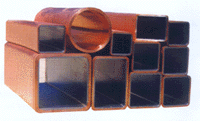|
1.Copper mould tube( square ,rectangle and round )
2.Crystallizing equipment of continuous casters
3.Mould cooling jacket.
4.repair of copper tube moulds |
COPPER MOULD ALLOYS
|
The copper alloys chosen for the moulds must maintain their physical properties at the operating temperatures of the continuous casting process.
The temperature gradation from the inner wall of the mould to the outside face of the mould can cause serious distortion problems ,and it is imperative that the correct alloy is chosen for the various operating conditions. |
STANDARD MATERIALS
|
Phosphorus de-oxidised copper
This alloy has been proven to be excellent for the manufacture of moulds in the continuous casting of billets .The main composition of this alloy are Cu + Ag 99.90min,P0.0015/0.040.
Copper -Silver alloy
The addition of a small amount of silver ,whilst not increasing the melting point of copper ,does increase the recrystallisation temperature by almost 100¡æ,and also helps to give better thermal conductivity at the operating temperatures.
This alloy is normally used in moulds for the continuous casting of blooms and slabs .In this case ,the moulds are much thicker than in the billet moulds ,and the moulds temperature can be higher.The main composition of this alloy are Cu+Ag99.90 min. Ag 0.08/0.12 O 0.004/0.012.
|

|
|

|
COPPER MOULD TUBE
|
The continuous casting of molten steel into billets ,blooms and slab products ,has been highly refined over the years into an extremely sophisticated system .The continuous casting process is expected to produce metallurgically sound products at the lower possible cost ,and this is being achieved in many steelworks throughout the world.
Copper moulds have played an important role in the development of the continuous casting process .Their funcition is to receive the molten steel and to allow rapid heat transfer from the steel to the cooling water to enable quick solidification.
The mould must exhibit excellent thermal conductivity ,be resistant for thermal erosion ,and be resistant to distortion from thermal stress .So far only copper and a few copper alloys meet the above conditions ,both economically and technically. |
|
SOLIDIFICATION
The rate of solidification in the continuous casting process dictates the speed of production .The molten steel ,which is in contact with the inner faces of the copper mould ,starts to sllidify as rapidly as the heat is extracted ,forming a shell .The shell increases in thickness as more heat is extracted ,and eventually total solidfication is achieved .the process is similar to the solidification of ingots in ingot moulds .In continuous casting ,the whole process is speeded up ,with the aim to produce and homogeneous shell growth.
Consequently ,the mould is an important part of the continuous casting process ,and the manufactured quality of the mould plays and important role in their length of life. |
INNER SURFACE COATINGS
|
 |
Over the years ,Metallurgists and Engineers have been working together to develop better continuous casting moulds .The steel companies require a more economical mould which will give a longer service life .Surface coating of the inner walls of the mould has given the best results to date .Coatings available are Chromium and Nickel plating .Also,a combination of the two give good results on slab casting. |
|
|
|
SPECIFICATIONS OF COPPER MOULD
size |
90x90 100x100 110x110 115x115 120x120 130x130
135x135 140x140 150x150 160x160 200x200 150x180
150x220 130x240 160x200 180x220 220x220 240x240 |
radius |
4000 5000 5250 5560 6000 7000 7500 8000 9000 10250 120000 |
length |
700 750 780 800 810 812 850 900 |
unlt:mm |
|
|
|